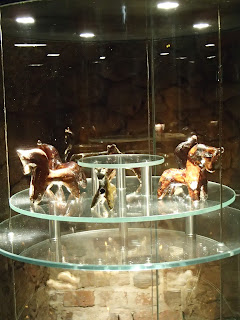Back in Todi, tonight was the "notte bianca" ("white night") which means all-night street party (until dawn, hence "white"). There were long picnic tables and benches in the entire piazza, booths selling beer and snacks, and a stage at one end.
The act started around 11, I think, and had us in stitches. Picture this: five men, one woman dressed in country/mild grunge, black banner that had the Iron Maiden font spelling out Iron Mais (Mais means "corn" or "maize") with an ear of corn. In other words: a hard rock band with a country sound. Hard to picture? Trust me, we were in stitches.
Ever thought about what Mick Jagger would sound like using a banjo accompaniment? Yup, we heard that tonight (along with a light show/display throughout the piazza and onto the Duomo). And much more.
The bass player had a special paint job that made his instrument look like a shark. Next to the microphone was a miniature barbecue grill on which were resting a pink rubber pig and green rubber chicken.
 At one point, interspersed with the English-language hard-rock-with-a-twang, they played a song (in Italian, called "Pop Porco") which was essentially a ballad to the pig. Yes, this was about the pig-as-food: they waxed lyrical about the "aroma of the crackling skin" and "panini" and "porchetta" (a local specialty of roast pig), and more. In between singing, the lead singer picked up the pig from the spit and had it squeak into the mike. Absolutely priceless.
At one point, interspersed with the English-language hard-rock-with-a-twang, they played a song (in Italian, called "Pop Porco") which was essentially a ballad to the pig. Yes, this was about the pig-as-food: they waxed lyrical about the "aroma of the crackling skin" and "panini" and "porchetta" (a local specialty of roast pig), and more. In between singing, the lead singer picked up the pig from the spit and had it squeak into the mike. Absolutely priceless.
We were looking them up to show Eleanor, and it turns out they've actually been on the Italian version of X-factor!
They also later played a song (in English) which talked about how delicious pig is, as well.
All in all, it was a hilarious concert. And it was just delightful because everyone's out and about and the shops are open. People of all ages (from 5 days old to easily in their 90s) are meeting and greeting and enjoying the slightly cooler evening.
Love,
Alexandra
The act started around 11, I think, and had us in stitches. Picture this: five men, one woman dressed in country/mild grunge, black banner that had the Iron Maiden font spelling out Iron Mais (Mais means "corn" or "maize") with an ear of corn. In other words: a hard rock band with a country sound. Hard to picture? Trust me, we were in stitches.
Ever thought about what Mick Jagger would sound like using a banjo accompaniment? Yup, we heard that tonight (along with a light show/display throughout the piazza and onto the Duomo). And much more.
The bass player had a special paint job that made his instrument look like a shark. Next to the microphone was a miniature barbecue grill on which were resting a pink rubber pig and green rubber chicken.
 At one point, interspersed with the English-language hard-rock-with-a-twang, they played a song (in Italian, called "Pop Porco") which was essentially a ballad to the pig. Yes, this was about the pig-as-food: they waxed lyrical about the "aroma of the crackling skin" and "panini" and "porchetta" (a local specialty of roast pig), and more. In between singing, the lead singer picked up the pig from the spit and had it squeak into the mike. Absolutely priceless.
At one point, interspersed with the English-language hard-rock-with-a-twang, they played a song (in Italian, called "Pop Porco") which was essentially a ballad to the pig. Yes, this was about the pig-as-food: they waxed lyrical about the "aroma of the crackling skin" and "panini" and "porchetta" (a local specialty of roast pig), and more. In between singing, the lead singer picked up the pig from the spit and had it squeak into the mike. Absolutely priceless.We were looking them up to show Eleanor, and it turns out they've actually been on the Italian version of X-factor!
They also later played a song (in English) which talked about how delicious pig is, as well.
All in all, it was a hilarious concert. And it was just delightful because everyone's out and about and the shops are open. People of all ages (from 5 days old to easily in their 90s) are meeting and greeting and enjoying the slightly cooler evening.
Love,
Alexandra























































